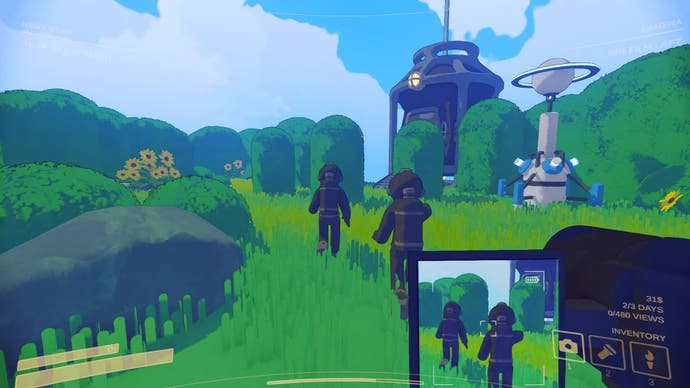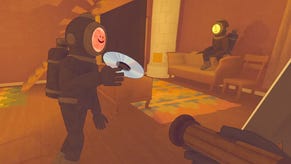Content Warning review - a funny but forgettable 15 minutes of fame
Link in BOO!
The survival horror multiplayer has mastered publicity stunts, but it doesn't make a lasting impression.
There are several things that nearly everyone agrees are annoying. Processing fees, for example. Drain flies that flit around your face before dive-bombing your beer can. Likewise, "influencers" - TikTok creators, YouTubers, and other hair-gelled 22-year-olds - tend to inspire bone-deep resentment, which could be why Content Warning doesn't mind tossing them into a horror game.
But, unlike your displeasure with dumb flies, influencer fatigue also tends to ripple with jealousy: "Why don't I have one bajillion followers?" you might find yourself wondering at weak moments, when work feels particularly crushing. "MrBeast doesn't even really cure blindness." So, in being a multiplayer game, Content Warning feels like an effective satire of our widespread obsession with attention. Most of the time, though, it's just as forgettable as the impulse to be seen and loved by everyone forever.
It's a losing game. Literally and figuratively. In theory, Content Warning functions similarly to Steam-favourite survival horror multiplayer, Lethal Company. In three-day cycles, you and up to three other aspiring SpöökTubers must descend into a charcoal pit. Your goal is to film something disturbing, go viral, and make money. You're Logan Paul, and your brain functions at quarter speed. So you go into the pit with a depleting oxygen tank, and you will yourself to live long enough to ride a stifling diving bell back to the surface, upload your footage to a computer, and watch the ad revenue come rushing in.
That's how it's supposed to work, but, barely a week after its popular, free April Fool's Day launch, I notice that online randoms are already prematurely ending games. As of writing, Content Warning may have fallen far from its initial 204,000 player peak, but it's still attracting an impressive 55,000 concurrent players. Fellow 2024 indie breakout Palworld can relate to that; it's sitting in a similar spot after dominating video games' otherwise dead winter. But all of the games I played in preparation for this review wrapped up after only one day of awesome, viral, white guy notoriety because my teammates disconnected.
I didn't play any private games, though save file options make it possible for you to play either with friends, or alone. The latter is mostly useless - in my two attempts at solo play, I died within the first two minutes of exploring the bleak pit, or what the game calls "the old world."
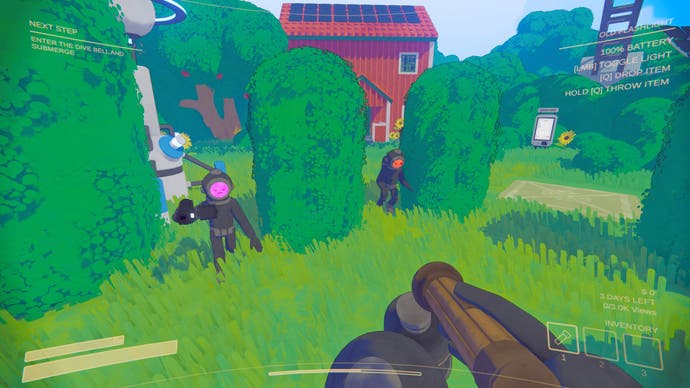


First, I died by stepping into a string trap, my health draining in nasty, big bites until there was none left to take. Then, I was exploded by a wandering bomb, one of the many Silent Hill-looking monsters that stalk the old world and make it grim, but hardly ever scary. I kept encountering Whisker, for example, a teetering wraith with a whirring hand mixer for a head. I was defenceless, holding only my all-important film camera, which one player per game uses to film spooks and take selfies. Whisker followed and menaced me, but I was never really afraid, because I'm not a bowl of egg yolk.
Even in the selfish, online world of personal branding, you need buddies to help you get out of any real trouble. So Content Warning is effectively an online multiplayer-only game, a quality I initially found vexing as a woman. Though it's not mandatory to use voice chat in-game, it is immensely useful for planning footage and coordinating your group's escape to the surface. In my experience, male-dominated voice chat rooms can be hostile to women, so I was initially uncomfortable playing Content Warning.
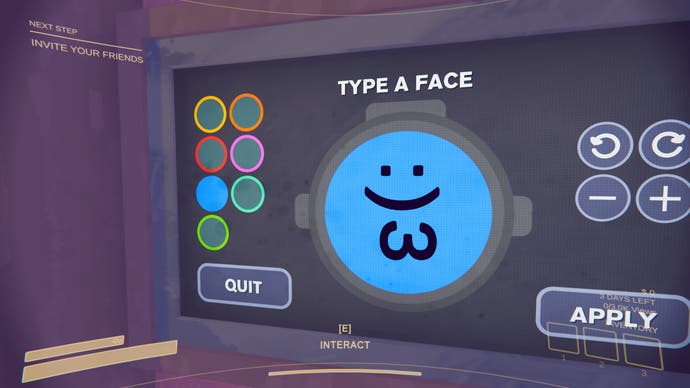

Then I realised no one is taking it seriously, except, maybe, as a voiceover opportunity. In each game I played (with, as I suspected, seemingly all-male players), at least one person appointed themselves the unofficial group leader and lead roleplayer. Once, after we each selected our bright, butt-chin emoticon faces and left the taffy-coloured cottage where all games start, my cheerful teammate welcomed us all "back to another video." I was dazed, for a second, and wondered if I had been sucked into a Twitch stream. Then I realised that he'd grabbed the camera and was speaking to it in selfie mode. Later, another player shrieked about "the Japanese suicide forest," completing his mind meld with Logan Paul, and making me laugh. I was surprised.
The absurdity of voice chat, despite my reservations, is the best part of Content Warning. The game has certainly built in some of its other humorous aspects, like its gummy-looking avatars that hold flashlights in one, fully extended arm. They appear to me like doltish football players worried that the ball is coated in Uranium. And, if you manage to push a game through its complete three-day cycle, you can use the SpöökTube money you earn to buy similarly droll props for your videos and emotes, like a "Goo Ball" ($150) or "Ancient Gestures 1" (the middle finger), which are essentially your only tangible motivations for completing a full three-day playthrough. Content Warning has no narrative or progression system beyond making money, which feels as hopeless as it sounds.

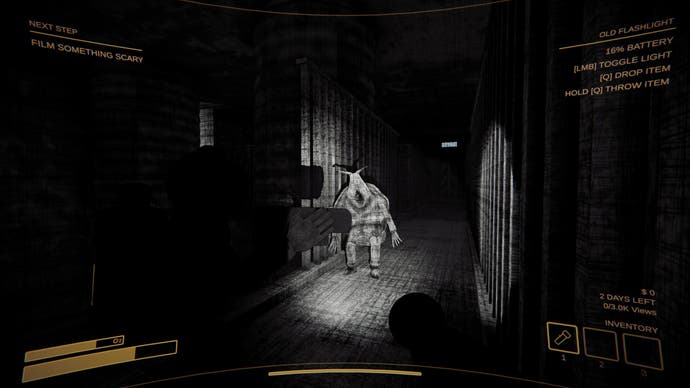
So the game itself is rarely as entertaining as Content Warning's other players, who, I've noticed, can scream, whine, and overact as convincingly as the most embarrassing apology video. "I have a flashlight…and a pretty decent idea of how to use it," I heard a player lie, anxious after getting separated from the pack. "OH MY GOD!" my teammates later cried as I sacrificed myself for views, allowing a monster to maul me.
That's the other thing I like about Content Warning - it's actually a content creator role-playing game. The most effective way to get famous is to let yourself get gored while someone else films, or decide who you care about least and request that they do something horrible. I noticed myself getting frustrated as I watched teammates run from hulking enemies, their flashlights uselessly pointing out the barren paths ahead of them. "Do something cool" I wanted to scream, "like throw yourself into the meat grinder!" Content Warning cunningly encourages this Lord of the Flies debasement. Lifting and aiming its grainy film camera adds a sense of remove from your reality, a closed door between you and the action.
To put it another way: "In photography, we see nothing," wrote French philosopher Jean Baudrillard in his 1999 essay, Photography or Light Writing. "We are never in the real presence of the object. Between reality and its image, there is an impossible exchange."

In Content Warning, and in the types of heartless content it's parodying, that exchange is not very beautiful. It requires you to give up your empathy, because you'd always figured that attention was more vital. It's a ridiculous human impulse, so Content Warning is a ridiculous game. On purpose.
I can work with that, but here's the problem: light always cuts through the dark. And Content Warning's dropping player count - natural as that may be for any game after its initial release window spike - tells me that indulging in this forbidden impulse, to want to be seen, no matter what, is a passing trend. Without its funny players, Content Warning is too insubstantial to make a lasting impression. Like other sarcastic games concerned with our high-consumption culture - the 2021 "anti-visual novel" Class of '09, or the forthcoming reality TV sim The Crush House - Content Warning reflects a godlike indifference. We've all internalised it by living, mostly, through screens. But indifference isn't enough fuel for getting inspired, and I think we'll eventually realize that it never has been.
A copy of Content Warning was provided for review by Landfall Publishing.
